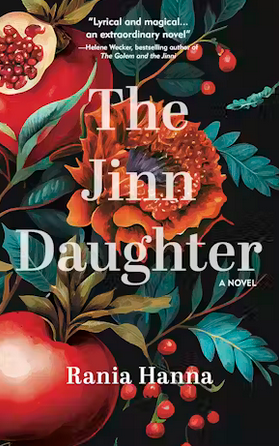The Jinn Daughter: A Novel
- By Rania Hanna
- Hoopoe
- 274 pp.
- Reviewed by Bareerah Y. Ghani
- April 25, 2024
A mother maneuvers the realm of death to save her daughter in this overly ambitious debut.

In Rania Hanna’s debut novel, The Jinn Daughter, Nadine, a Hakawati Jinn, dutifully tells “the stories of the dead,” sending their souls to Mote, a final abode, or Jehannam, a place of eternal suffering. Every morning, Nadine collects the souls of the dead that fall from the sky outside her cottage in the form of pomegranate seeds. She presses these seeds, drinks the juice, and then weaves “stories in the air.”
Nadine’s role in the village is essential. Without her, souls would not pass into death, and the land would be “overrun with ghouls.” She is also one of the few jinns still alive; others were killed or imprisoned in “metal amulets, in lamps.” Despite this, Nadine and her half-jinn, half-human daughter, Layala, suffer the villagers’ scorn.
“They called me witch and death-bringer,” Layala complains.
Beyond the name-calling, though, the townsfolk cannot harm the two, protected as they are by their association with the village sheikh, Hamadi, Layala’s grandfather and, ironically, the man responsible for the persecution and imprisonment of jinns that started the Jinn Wars. The novel is rich with such backstory, offering it in the form of short, folkloric fables that strike an eerie, mystical mood.
Much to the reader’s dismay, however, these are the extent of the book’s play with the uncanny. The sense of haunting and dread is tapered in the narrative’s “present,” which focuses on the somewhat complicated relationship between Nadine and Layala.
Nadine wishes to raise her daughter as human, away from the lure of magic, while Layala, like the average teenager, is curious about all that is forbidden. Nadine often lies to her daughter, withholding the extent of her powers, particularly hiding the fact that Nadine can visit Layala’s father, Ilyas, in “death” (the imagined underworld where Ilyas’s soul waits, unable to pass on because Nadine has preserved his soul-seed in a jar in her cottage).
The mother-daughter relationship becomes more fraught when Nadine discovers Layala is keeping secrets about meeting a jinn boy, Rami. Hanna captures the struggle with single parenthood via Nadine’s battling with her protective instincts as she strives to give Layala space to have her own experiences, deftly highlighting the agony of losing a partner and illuminating how nothing compares to their physical presence.
“I wish you were still alive. And that you were there with me, with us,” Nadine says to Ilyas during a visit. Another time, she sits next to him, silently wishing he could hug her, hold her, but his presence in “death” is a mere shadow. Then, knowing it is impossible, she consoles herself by thinking, “At least you can see him, talk to him, even if you can’t touch him or smell him.”
The plot accelerates when Nadine discovers the pomegranate seeds have stopped falling, and she can no longer enter “death” and visit Ilyas. Something sinister is afoot, she is sure. Then Kamuna, Death herself, pays Nadine a visit, reminding her, “You owe me a favor.”
Kamuna wants Layala to replace her as Death; this, she claims, is her right since Kamuna “raised” Layala (who died as a child). Now, Layala must relinquish the life she’s been lent. Such crucial information is — unfortunately — filtered through dialogue, which mutes its impact and also raises questions. For example, while convincing Nadine that giving up Layala is the key to solving the issue with the absent pomegranate seeds, Kamuna says, “It’s rare someone touched by death lives for as long as [Layala] does with no health issues. You know this, Hakawati.”
This makes the reader wonder: Wouldn’t this knowledge — that Layala was essentially living on borrowed time — manifest much earlier on in Nadine’s worries about her daughter? In this manner, the novel begins to lose some of its footing; the details around its worldbuilding become murkier, sparking confusion about what is happening (as when Kamuna tells Nadine, “My tree is ill…Death is sick”).
But isn’t Kamuna herself Death? The distinction between Death as character and death as realm isn’t clear. At several other places, too, the plot seems to rush past the narrative’s need to offer more clarity, such as about Rami and his intentions with Layala, which, until the end, are perceived only through Nadine’s skeptical lens and thus leave the reader wondering whether to trust the young man.
With all this said, The Jinn Daughter has its merits. Hanna’s portrait of a mother’s love and desperation is compelling, and readers will want to find out if Nadine saves Layala from the clutches of Death. And while the book’s climax feels a bit jarring because new characters (including Mother Earth) suddenly appear, there’s a bittersweet resolution to Nadine’s journey as a mother learning to let go. It’s also earnest in its emotional arc, and its imagined world is vast and fascinating. Alas, several craft-based issues hinder the proper execution of the author’s creative vision, rendering this story too ambitious for a writer yet to grow into her skills.
Bareerah Y. Ghani is a Canadian-Pakistani writer. She holds an MFA in fiction from George Mason University, serves as the fiction editor at Lakeer Magazine, and has attended the 2024 Tin House Winter Workshop. Her work has appeared in the Rumpus, Electric Literature, Moon City Review, and other places. Follow her on Twitter at @Bareera_yg or Instagram at @bareerah_ghani.

_80_122.png)